Garter Snakes are a very common wild snake found across most of North America and Canada.
Any snake from the genus Thamnophis is a type of Garter snake.
It is common to find this species near gardens, ponds, forests and wetlands. This leads to many people calling them garden snakes.
Garters are easily identified by their small slender bodies and distinctive dorsal stripe.
Let us dive into 21 different types of garter snakes so you can learn how to identify them if you find one in your yard.

Garter Snakes
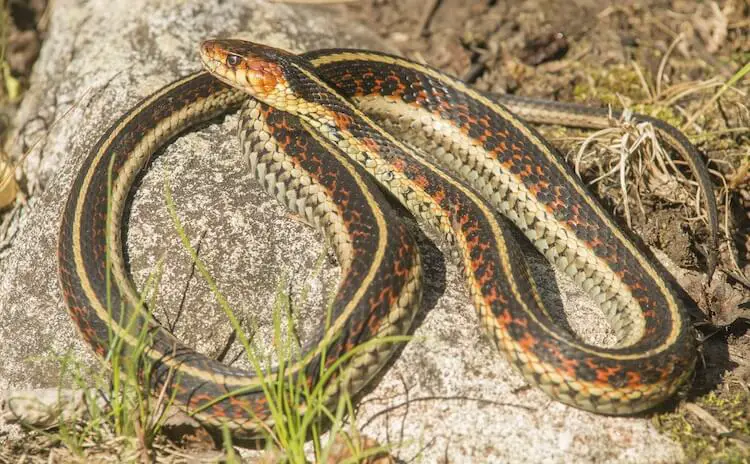
The garter snake is a general term used for any snake in the genus Thamnophis. However, many people mean actually mean the common garter snake (Thamnophis sirtalis) pictured above.
Common garter snakes live in a wide range of habitats across North America. They were first documented in 1758 and are divided into 13 subspecies.
Some of the most common subspecies include:
- Eastern – found east of the Mississippi River and in Ontario.
- Red-Sided – inhabits the Dakotas, Nebraska, Missouri and central Canada.
- Valley garter – lives in northern California and up the Pacific coast to British Columbia.
The Thamnophis genus used to be considered an independent subfamily of the much larger Colubridae family. Garter Snakes were recently reclassified under the Natricidae family with other species such as the North American water snake.
In the wild it is common to find garter snakes near ponds, forests, grasslands and wetlands.
Their small size and adaptability mean they can easily live in different environments and habitats.
They are a solitary species that only aggregate over the winter to share communal dens as they brumate. They will later emerge in large numbers in the spring to breed. Their tendency to form masses of hundreds or thousands of snakes while mating is referred to as a breeding ball.
What Is The Difference Between A Garden Snake And A Garter Snake?
The difference between a garden snake and the garter species is misunderstood by many people. This has led to many families of snakes (e.g. Ribbon, Brown and Garter Snakes) being grouped together and called garden snakes.
Garden Snakes is a general term used for any species that is commonly found in yards. This can include the Garter species but also includes Copperheads and Ribbon snakes.
Garter snakes are a specific species of snake in the genus Thamnophis that are commonly found in gardens.
Are Garter Snakes Dangerous?
This species poses no threat to humans.
Garter Snakes are rear-fanged and mildly venomous, but this venom is extremely mild. It is designed to help them subdue and capture prey – not humans. Their venom is nothing to worry about. They are actually a very popular pet among reptile keepers.
Do Garter Snakes Bite?
It is rare for a Garter Snake to bite humans. They will only bite if there is nowhere for them to flee to. As they are mildly venomous a bite can cause itching and in some cases minor swelling.
Wild garter snakes will likely be shy and defensive when first discovered. This is normal.
You should not attempt to handle a wild individual unless they are relaxed. Keep in mind this species can move very quickly when they want to. Their small size means they can easily fit under rocks and evade being held.
How To Identify Garter Snakes
Garter Snakes vary widely in appearance, color and pattern.
There are a few key characteristics that can be used to identify many types of Garter Snakes.
Every garter snake has keeled scales and small heads with large eyes.
Many species are brown or black in base color. They then have a series of lighter stripes running down the length of their body. But, this does not apply to all species, as you will soon learn how to identify them!
Common Garter Snakes are normally bluish-gray or black. They have one bright stripe down their spine and a lighter cream stripe on either side of their body.
Types Of Garter Snakes
1. Common Garter Snake
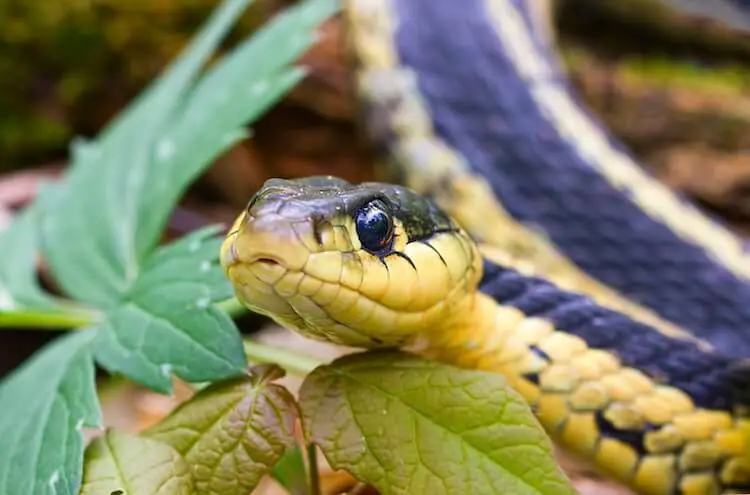
The Common Garter Snake is one of the most widespread wild snakes in North America.
They have a large range across every state east of the Mississippi River and many states west of the Mississippi. Some species live in many parts of Canada too.
Common species have an olive, tan, gray or black base color with at least one cream longitudinal stripe. They normally grow to around two feet in length, but some very large individuals, reaching four feet.
There are actually 13 subspecies of Common Garter Snakes. Each subspecies has a unique color and pattern. Red-Sided subspecies have bright red or orange side markings.
- Species: Thamnophis sirtalis ssp.
- Range: East and West of the Mississippi River.
- Color: Tan to black with lighter patterns.
- Markings: Stripes, blotches or checkerboard.
2. Eastern Garter Snake
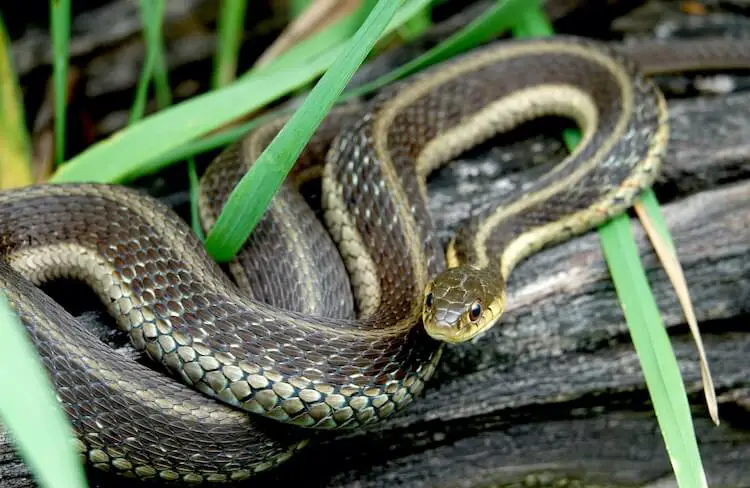
The Eastern Garter Snake is one of the most commonly encountered snakes in the Eastern United States. This snake can be found anywhere east of the Mississippi River to Vermont and New Hampshire and south of Ontario to the Florida Keys.
Eastern Garters come in different patterns and colors depending on which region they come from.
Their base color is normally a shade of tan, olive, brown or black. The pattern varies from stripes, blotches or spots that can be cream, yellow, gold or even blue.
Most individuals have at least one longitudinal stripe (normally on the spine).
This species normally grows from 18 to 26 inches.
- Species: Thamnophis sirtalis sirtalis.
- Range: East of the Mississippi River to Vermont and New Hampshire.
- Color: Tan, olive, gray, brown or black.
- Markings: Longitudinal stripes and spots on dorsum.
3. Albino Garter Snake
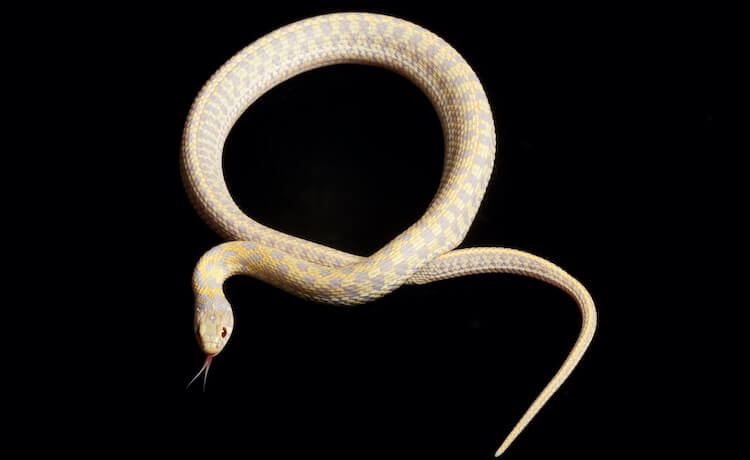
The Albino Garter Snake is a genetic color morph that occasionally appears in wild species.
It is very rare to see this snake in a yard.
Many Albinos are part of a reptile collection that have been bred from a Checkered and Plains Garter Snake.
The difference in this species is their color. Their pattern and size do not differ from wild-types.
Normal Garter Snakes are typically olive, gray or black with yellowish markings. Albinos are a combination of white, cream, yellow, orange and peach. They also have iconic pink albino eyes.
- Species: Thamnophis marcianus.
- Color: White, cream, yellow, orange and peach.
4. California Red-Sided Garter Snake
The California Red-Sided Garter Snake is one of the most striking snakes in this list.
As their red common name suggests this snake has very bright red markings on its side. If you have one in your yard, they’ll be quite hard to miss with their striking appearance.
California Red-Sided species have red heads and black bodies with red bars along the side. The vertebral stripe is the same color as their belly which is normally cream.
This type of Garter snake is found in California and along the central and Northern coast.
- Species: Thamnophis sirtalis infernalis.
- Range: California.
- Color: Black background with red side pattern.
- Markings: Barred sides with vertebral strips.
5. Blue-Striped Garter Snake
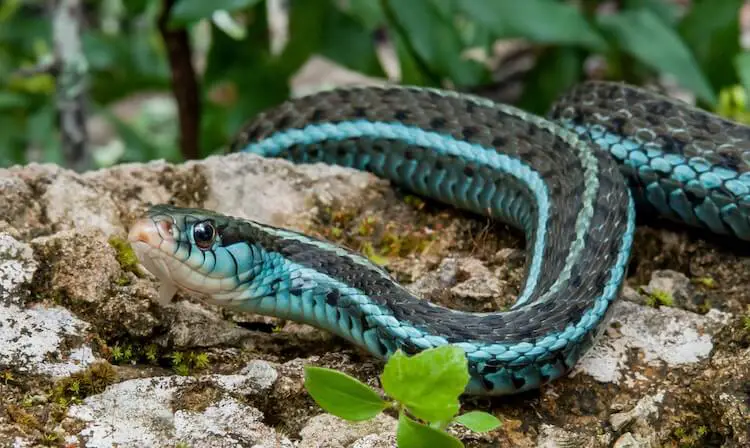
The Bluestripe Garter Snake is one of many subspecies of the Common Garter Snake.
Blue-Striped Garter Snakes have the same dark gray base color as most Garters, but their stripes look as if they were painted on with a blue highlighter. They have blue stripes running down the top and sides of their body. The blue sides end on a ventral surface that is normally a blueish-white.
Interestingly this subspecies has a very small range along the Gulf Coast of Florida from Apalachee Bay to Tampa Bay.
This species is not known to grow particularly big and reaches 18 to 26 inches in length.
- Species: Thamnophis sirtalis sirtalis.
- Range: Apalachee Bay to Tampa Bay.
- Color: Tan, olive, gray, brown or black.
- Markings: Longitudinal stripes and spots on dorsum.
6. Checkered Garter Snake
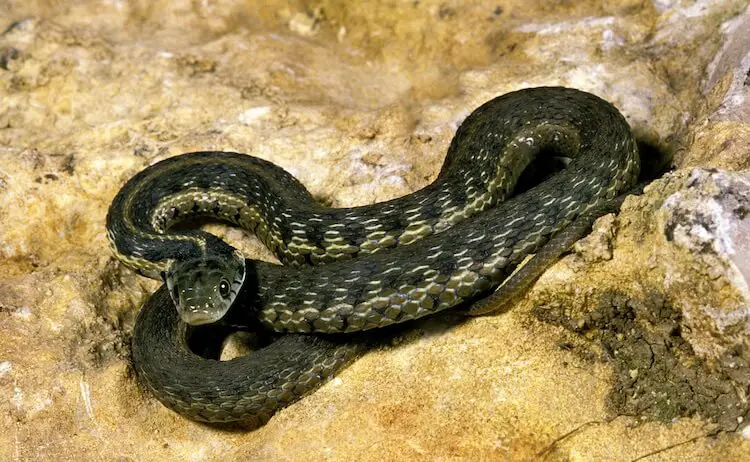
The Checkered Garter Snake can be found in many parts of Texas and parts of New Mexico, Oklahoma, Kansas and Mexico.
These snakes generally have a tan to olive base color with a bright vertebral stripe.
Checkered Garters have a checkerboard pattern of light and dark markings unlike the normal stripes of many Garters in this list. Checkered species also have dark stripes below their eye.
Albino species are also popular and occur naturally in the wild. They are also well-established in the pet trade.
- Species: Thamnophis marcianus.
- Range:Texas, New Mexico, Oklahoma, Kansas and Mexico..
- Color: Tan to olive with darker markings.
- Markings: Checkerboard pattern.
7. Plains Garter Snake
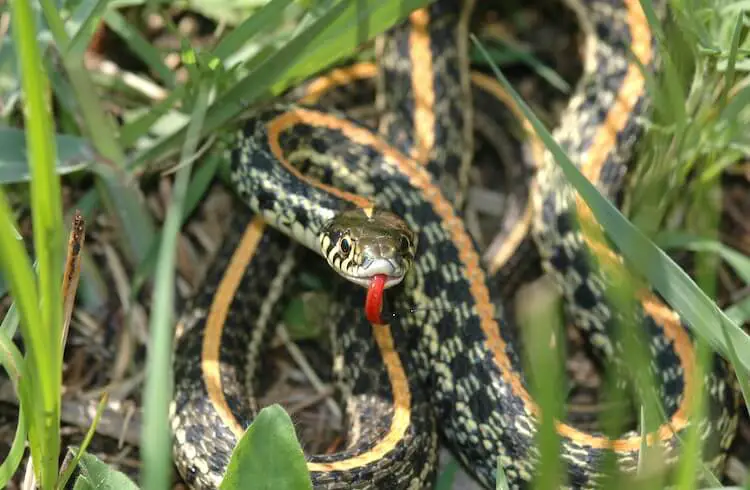
The Plains Garter Snake has a large range across the central United States and southern Canada.
They have a similar appearance to several species such as the Common, Butler’s and Black-Necked Garter Snake.
Plains Garters have a bold vertebral stripe ranging from light cream to a golden yellow-orange.
Their sides can be solid black or made up of a series of darker markings across a cream, olive or gray base. Some individuals have a reddish base but this is rare.
Although they can grow larger most species grow to 28 inches.
- Species: Thamnophis radix.
- Range: Central United States and southern Canada.
- Color: Dark green, red, brown or black.
- Markings: Bold vertebral stripe.
8. Red-Sided Garter Snake
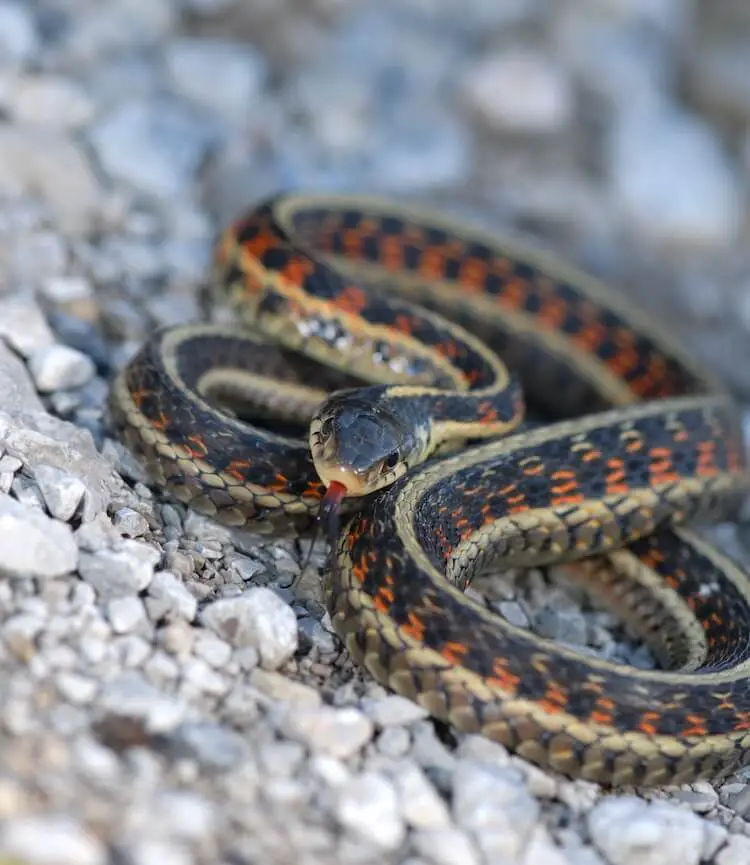
The Red Sided Garter Snake is one of many types of Garter Snakes. This subspecies is found farther North than any other species and has a large range across the Midwestern United States and well into Canada. However, they are not very common so it is rare to see them in a garden or yard.
Red Sided individuals have a dark olive, brown or black base color with a light cream or yellow vertebral stripe.
As their name suggests they have a series of red or orange bars on their sides.
Some snakes have a red and black pattern (like the checkerboard) and others have very small amounts of red.
Red-Sided Garters typically grow from 18 to 26 inches.
- Species: Thamnophis sirtalis parietalis.
- Range: Midwestern United States and Canada.
- Color: Brown, olive or black.
- Markings: Light stripe with a red or orange side pattern.
9. Black-Necked Garter Snake
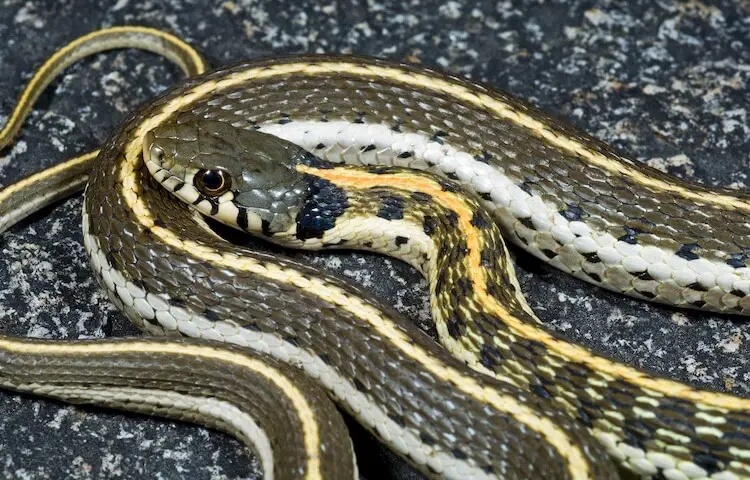
There are two different subspecies of Black-Necked Garter Snake:
- The Eastern Black-Necked.
- The Western Black-Necked.
Black Necked Garter Snakes live in Texas, New Mexico and some parts of Colorado.
These snakes are easy to spot because of the black markings that run on the side of their necks. This species also has a bright, yellow to orange stripe that runs down its spine.
The pattern on the sides of their body is variable but often has yellow blotches. In some individuals the cream blotches extend giving them a striped appearance.
- Species: Thamnophis cyrtopsis ssp.
- Range: Texas, New Mexico and Colorado.
- Color: Black, gray or olive.
- Markings: Yellow to orange blotches.
10. Chicago Garter Snake
Chicago Garter Snakes are found around the Chicago area of Illinois, Indiana and Wisconsin. They share part of their range with the Eastern Garter Snake.
At first glance this snake looks just like a Common Garter. They are black, gray, olive or tan with cream or yellow longitudinal stripes. After a few seconds you should be able to notice this species has vertical black bars on its neck.
The adult Chicago species normally grow to around three feet long.
Due to their small range and similar appearance this snake is often misidentified.
- Species: Thamnophis sirtalis semifasciatus.
- Range: Illinois, Indiana and Wisconsin.
- Color: Black, brown, gray, tan or olive.
- Markings: Cream stripes and black bars on neck.
11. Western Terrestrial Garter Snake
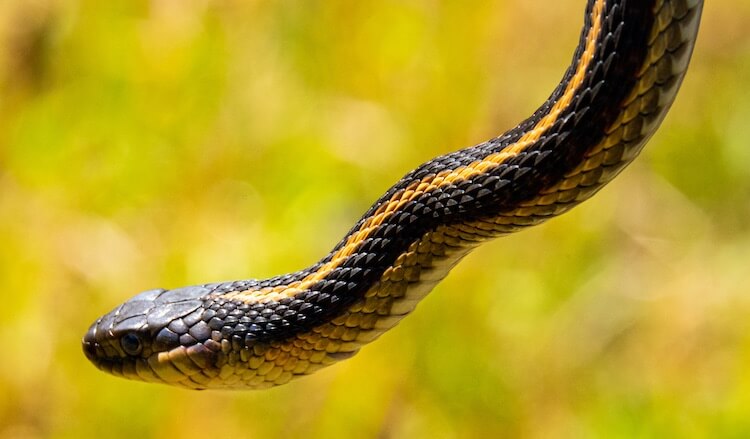
The Western Terrestrial Garter Snake is a complex species made up of several subspecies.
Each subspecies have different ranges, appearances and common names. This is the reason why Western Terrestrials have some of the greatest variability of all Garter Snakes.
All Western species have longitudinal stripes. But, these stripes can be very well-defined or not very defined at all. Their background can be solid, blotched or checkerboard. The base color is normally gray to black. Some individuals can have more brown or tan coloring.
The pattern can be white, cream, yellow, orange, red, brown or even blue.
Their appearance is based upon the subspecies and location. Western Terrestrials are found throughout the Western United States, Southwestern Canada and Baja California.
- Species: Thamnophis elegans ssp.
- Range: Western United States, Southwestern Canada and Baja California.
- Markings: Longitudinal stripes, blotches, checkerboard or little pattern.
12. Blackbelly Garter Snake
Blackbelly Garter Snakes are one of the more unique species in this list.
Unlike many snakes in the genus Thamnophis, Blackbellies have solid-colored bodies which is very unusual.
Colors can be tan, gray, olive, brown, reddish, or jet-black. Some individuals are solid black or brown with red undersides. Their vertebral stripes and blotches are present but are often faint.
Blackbelly Garters do not grow very big and only reach two feet.
There are several subspecies of Blackbelly Garter Snakes found in central Mexico.
Due to the fact they are only found in Mexico you are unlikely to see one in your yard!
- Species: Thamnophis melanogaster ssp.
- Range: Central Mexico.
- Color: Black, brown, red, tan or olive.
- Markings: Faint blotches or vertebral stripes.
13. New Mexico Garter Snake
New Mexico Garter Snakes are only found in a small area of New Mexico.
Due to their small range it is not common to see them in the wild.
These snakes have similar patterns to other Garter Snakes with a yellow to cream vertebral stripe and two longitudinal stripes.
Their base color is the typical brown, olive, gray or black. Sometimes they have red in their base pattern between the scales.
- Species: Thamnophis sirtalis dorsalis.
- Range: New Mexico.
- Color: Black, brown, red, tan or olive.
- Markings: Lighter cream or yellow longitudinal stripes.
14. Santa Cruz Garter Snake
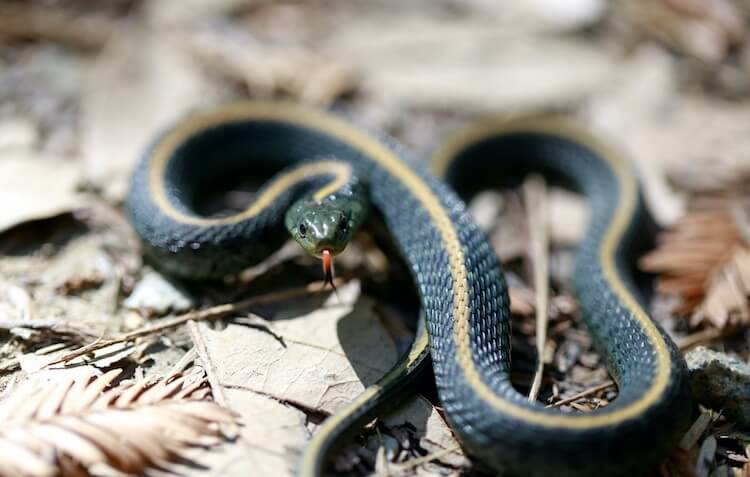
Santa Cruz Garter Snakes are normally called the Aquatic Garter Snake.
This subspecies inhabits a very small range in the Santa Cruz Mountains of California. It is very common to find them around bodies of water in California.
Santa Cruz snakes are a distinctive type of Garter Snake with a simple yet elegant color pattern.
These snakes have a grayish body color with darker blotches. They also have a broad vertebral stripe that is cream, yellow or orange.
The Santa Cruz Garters are larger than most snakes on this list. They can grow up to about 40 inches in length.
- Species: Thamnophis atratus atratus.
- Range: Santa Cruz Mountains of California.
- Color: Gray with cream, yellow or orange stripe.
- Markings: Vertebral stipe and darker blotches.
15. Valley Garter Snake
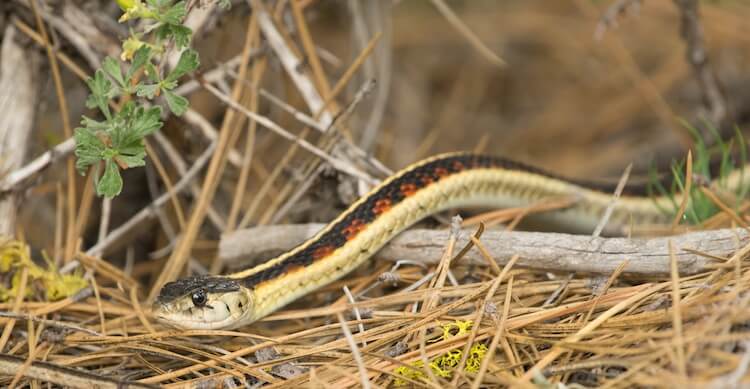
Valley Garter species are found in the Western United States and areas of Southwestern Canada.
This snake has very interesting colors, patterns and eyes.
These Garters have a gray, olive or black background color with cream, yellow or white longitudinal stripes. Valley Garters sometimes have red markings above the stripe on the side of their body. Aberrant individuals are sometimes found in solid black with red markings.
Their size is similar to most Common species at two to three feet in length.
- Species: Thamnophis sirtalis fitchi.
- Range: Western United States and areas of Southwestern Canada.
- Color: Gray, olive or black.
- Markings: Cream longitudinal stripes and red markings.
16. Texas Garter Snake
Texas Garter Snakes can be found in several different color variations.
Most Texan snakes have a dark olive or black base color with longitudinal stripes on the back and sides. The vertebral stripe can be cream-yellow but is often a pale orange. The side stripes can be bright white.
In vibrant individuals the white, black and orange colors create a beautiful contrast.
These snakes are not very common but they are striking enough to easily identify.
- Species: Thamnophis sirtalis annectens.
- Range: Texas, Oklahoma and Kansas.
- Color: Black or gray.
- Markings: Orange, yellow or white markings.
17. Short-Headed Garter Snake
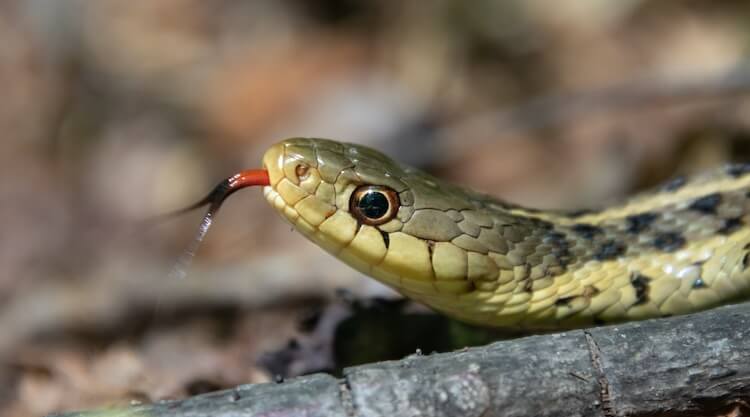
Short Headed Garters are a small and cute species.
These snakes look similar to the Butler’s Garter but have some unique characteristics that make identifying them easier.
Short Headed species have very short heads and blunt snouts.
They have a brown background color with lighter cream, tan, or dull gold longitudinal stripes. In rare individuals these stripes are very vivid.
Finally, this species is very small for a Garter Snake. Full grown adults are always under two feet.
- Species: Thamnophis brachystoma.
- Range: New York and Pennsylvania.
- Color: Brown with lighter-colored markings.
- Markings: Longitudunal stripes.
18. San Francisco Garter Snake
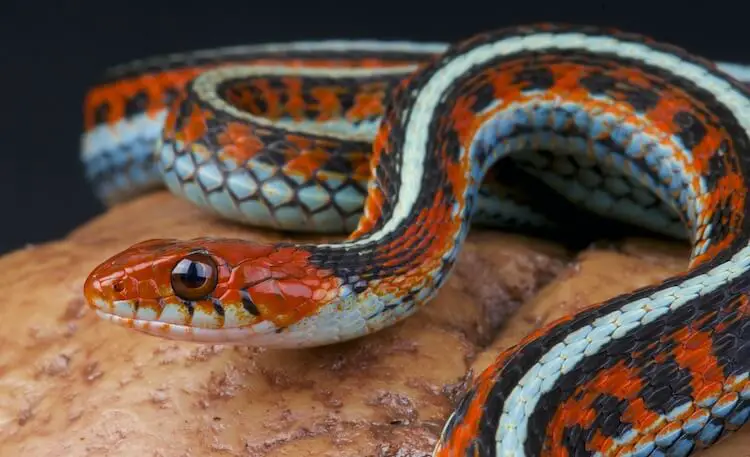
San Francisco Garter Snakes are considered the most beautiful snake on the planet.
They stand alone among all other species of Garter Snake due to their amazing and unique appearance.
San Francisco species are one of the most recognizable snakes on the planet.
The colors start at the vertebral stripe and go down the body in blue, black, red, black, and blue again. These snakes are similar to the Red-Sided species but are far more vibrant.
Color and patterns vary slightly, but you should expect this Garter to have longitudinal stripes of black, red and electric blue. The head is typically solid red and the underside is a beautiful electric blue or teal.
Unfortunately this subspecies is becoming increasingly rare and is classified as endangered by the International Union for Conservation of Nature.
- Species: Thamnophis sirtalis tetrataenia.
- Range: San Francisco.
- Color: Black, red and electric blue.
- Markings: Longitudunal stripes.
19. Butler’s Garter Snake
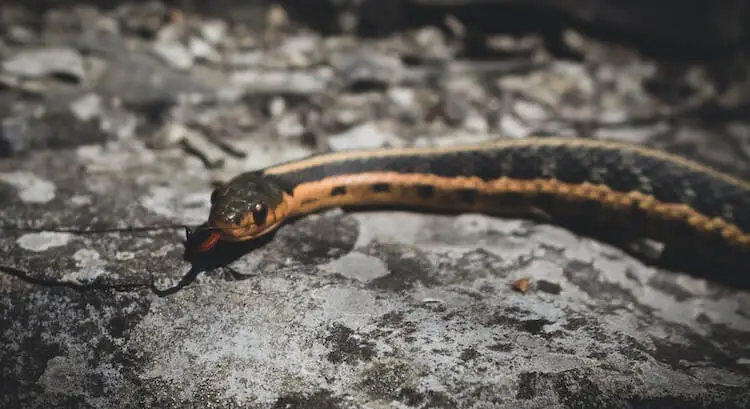
Butler’s Garter Snakes have a very general appearance.
This species has a black to brown background color that is broken up by three parallel stripes that run along their body. One stripe goes down the spine, the other two run along the ribs on each side.
They have keeled scales giving them a rough texture.
Butler’s snakes can be found in Wisconsin, Michigan, Indiana and Ohio. They are considered threatened in some of these ranges.
- Species: Thamnophis butleri.
- Range: Wisconsin, Michigan, Indiana and Ohio.
- Color: Black to brown.
- Markings: Three longitudinal yellow to orange stripes.
20. Narrow Headed Garter Snake
Narrow Headed Garter snakes are only found in a small section of mountains in central Arizona and New Mexico. These snakes are protected in Arizona so it is illegal to hunt, harass or collect them.
These snakes are sometimes called Narrow Headed Water Snakes. But, their narrow pointed head makes them unlike most Water Snakes. This is one of two reasons why the Narrow Headed Garter Snake is so unique. The other is that they do not have any longitudinal stripes.
These snakes are variable in color, but their pattern normally consists of a series of brown, gray or orange spots running down the length of the body.
- Species: Thamnophis rufipunctatus.
- Range: Arizona and New Mexico.
- Color: Olive, brown, tan and gray.
- Markings: Brown, gray or orange spots and blotches.
21. Giant Garter Snake
Giant Garter Snakes are the biggest Garter Snake. They typically grow four feet long and so are twice the average size of most Garters on this list!
This species is only found in central California valleys where unfortunately their range is decreasing due to habitat degradation. They are no longer found in much of their historic range and are considered threatened by extinction.
Like most species, the Giant Garter has a brown, olive or black base colors with a cream yellow vertebral stripe.
Their underside is typically grayish and some individuals have blotches down their sides.
- Species: Thamnophis gigas.
- Range: Central California valleys.
- Color: Brown, olive and black.
- Markings: Vertebral stripe and two longitudinal stripes.
Summary
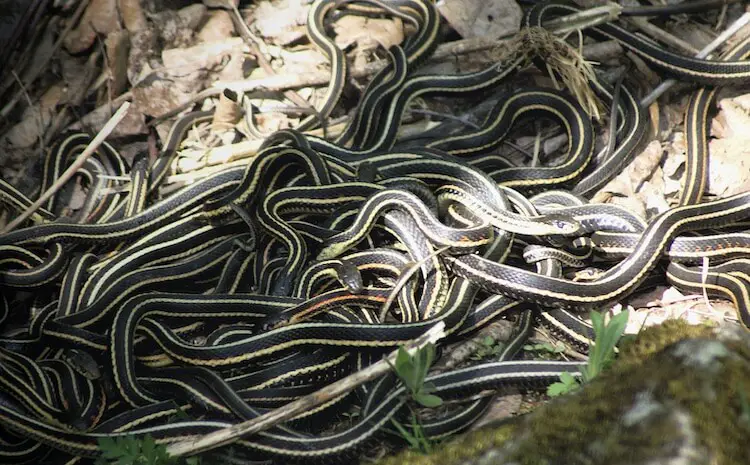
The Garter snake is an often misidentified garden snake.
They are small, active and very adaptable. Garters adjust easily to different habitats and are known to live nearby lakes, forests, mountains, grasslands, wetlands and gardens!
If you find this species in your yard they will likely be shy and defensive.
By educating people and letting them know about these beautiful species we hope that more people will protect them and be up to date on their conservation.
Have you seen a type of Garter Snake that is not mentioned on this list? Let us know below…


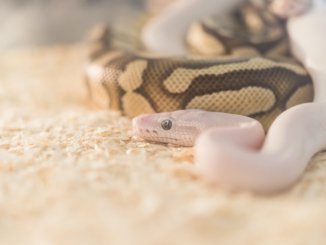
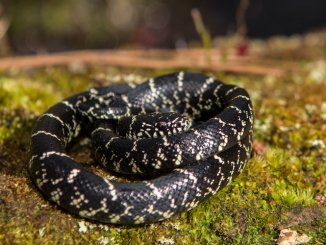
I was tearing down a greenhouse in Puyallup, Washington today. I surprised an electric blue striped garter snake! It was docile and about 14-16 inches long and quite well fed! A little while later I uncovered a greenish striped one, much smaller. Would a common northwest yellow striped snake mate with a blue and produce green striped offspring?
My Brother found a clear almost translucent or transparent baby snake in our yard in Northeastern Washington State, by our outside water faucet. Is that normal for baby snakes to be without color?
Would like to send a picture of a garter snake that captured a toad.
A snake and several others like it were seen in a creek near where a wildfire was raging and a photo was taken by a fire fighter. Location South Central British Columbia. Elevation: 3,400’
Someone told him it was a species of garter snake but I have been unable to identify it.
Is there a way I can send a photo for someone to identify it?
We live in Vermont and today found a dead blue garter snake by the side of the road…small, about 15 inches long. Solid blue underneath and blue stripes on top. Seems to be way out of its range!